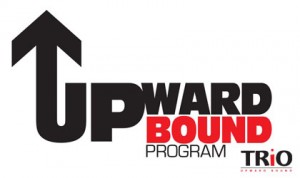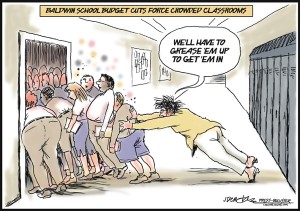RP Readers, here’s your opportunity to prove to one and all that you could sit for the SAT without breaking into a cold sweat:
Jon walked to work at an average speed of 6 miles per hour and biked back along the same route at 10 miles per hour. If his total traveling time was 2 hours, how many miles were in the round trip? Your choices are A. 6, B. 6.25, C. 7.5, D. 8, or E. 10.
Chances are you could probably narrow your choice down to two or three possibilities. But, what if you are a high school junior, enrolled in a school that is overcrowded and underfunded, sitting in classes taught in two languages, and nobody in your family has ever taken the SAT before? What are your chances then?
***
My friend Jack did not have to deal with those challenges when he was preparing to apply to college. The road was pre-paved, and Jack smoothed it out along the way as he studied for the SAT, applied to college, and eventually accepted admission at the University of Southern California.
When he got to USC, Jack caught the entrepreneurial bug. It’s like the “politics bug” – once you catch it, you have a hard time running away from it. Not far removed from taking the SAT himself, Jack started tutoring some family friends for the test. Two students quickly turned into ten, and Jack found that he had written enough of his own material to create a full-fledged pre-college outreach program. That’s how Study Smart Tutors was born.
***
This is a brief look into entrepreneurship and education. They are two worlds we don’t think of colliding; but, when they do, the reaction sparks unlimited possibilities. Like in any chemical reaction, however, there must be just the right amount of reactants…
• 1 Part Risk: Jack graduated college and decided to grow Study Smart Tutors. He turned down stable jobs that most recent college grads now dream of, trading them in for a seat behind the wheel of his own company. Recently, I asked him if he was nervous to take on the gamble that is entrepreneurship as a twenty-something. “Now is the time with the least risk,” he said. “When you’re young and unattached is the time to bet big.” Of course there are still nerves and concerns, and by Jack’s own admission, “things aren’t perfect, especially when there are no regular paychecks or bankable guarantees.” But he understands the risk he is assuming, and he knows that it will be more difficult to take these chances as he gets older.
 • 1 Part Market: In just a few years, Study Smart Tutors has changed to meet market demands. While it started as a one-on-one tutoring service offered at clients’ homes, the business has dropped that branch nearly entirely. Instead, Study Smart Tutors now looks to establish relationships with pre-college outreach programs that help underserved students prepare for, access, and succeed in postsecondary education. Also called “early intervention” or “college preparation” opportunities, federally funded programs such as Upward Bound and Talent Search target students who are at risk of not applying to, and thereby neither attending nor graduating from, college.
• 1 Part Market: In just a few years, Study Smart Tutors has changed to meet market demands. While it started as a one-on-one tutoring service offered at clients’ homes, the business has dropped that branch nearly entirely. Instead, Study Smart Tutors now looks to establish relationships with pre-college outreach programs that help underserved students prepare for, access, and succeed in postsecondary education. Also called “early intervention” or “college preparation” opportunities, federally funded programs such as Upward Bound and Talent Search target students who are at risk of not applying to, and thereby neither attending nor graduating from, college.
The developing marriage between Study Smart Tutors and pre-college outreach programs aims to close a lamentable gap. The suburban clients have been replaced largely by students – often of color and from low-income families – who have the opportunity to be first-generation college attendees. Affluent or not, these teenagers have just as strong a claim to a college education as any of their peers.
 • 2 Parts Challenge: Lately, our nation’s K-12 schools have been in the news for myriad reasons. 2,000 teachers and staff members throughout Los Angeles Unified School District face layoffs – and that’s down from 7,000 because of a recently approved four-day furlough. In 2009, roughly 45% of black and Latino males in Philadelphia graduated high school within four years. In 2008-2009, 50% of students in New York public schools faced overcrowded classrooms. These are Third World statistics, unacceptable anywhere, but most certainly in the United States.
• 2 Parts Challenge: Lately, our nation’s K-12 schools have been in the news for myriad reasons. 2,000 teachers and staff members throughout Los Angeles Unified School District face layoffs – and that’s down from 7,000 because of a recently approved four-day furlough. In 2009, roughly 45% of black and Latino males in Philadelphia graduated high school within four years. In 2008-2009, 50% of students in New York public schools faced overcrowded classrooms. These are Third World statistics, unacceptable anywhere, but most certainly in the United States.
And if that wasn’t enough, we mustn’t forget about the SAT. In 2009, SAT-takers who self-reported annual family incomes of more than $200,000 averaged a score of 1702 out of 2400 . . . those with annual family incomes of less than $20,000 averaged a 1321.
There are federal funds available for these college preparation programs, but the enrolled students have no control over the purse-strings. Let’s say Study Smart Tutors or a similar small business approaches an Upward Bound program. The program has a grant from the federal government that it is entitled to spend on college readiness instruction for its high school students. These fifteen- through eighteen-year-olds had to apply just to gain acceptance into the competitive Upward Bound program; thus, because of self-selection, it’s a reasonable assumption that the students actually want to take the SAT, score well, and apply to college. But if the administrators of the program shirk their responsibilities and dodge the calls of outside businesses looking to form partnerships, the students and their scores continue to languish. If Jack can’t get through to the program administration, a young entrepreneur and dozens of motivated high school students come away empty-handed. Everybody loses.
***
Ultimately, even though entrepreneurship straight out of college presents its uncertainties, the risks can be well worth taking, even for reasons beyond financial gains. By giving up the private tutoring branch of Study Smart Tutors, Jack waved good-bye to faster cash and more personal time. If you asked him five years ago if this was where he saw his small business headed, I’m sure he would have given you a resounding “No.” But now, according to Jack, “the best part, without question, is working and interacting with the students, and learning about their lives and the goals that they’re trying to accomplish. While I know those are not the most economically efficient things to do, I love it all, and it reminds me why this business has transformed.”
With a twenty-two-year-old recent college graduate taking risks to help at-risk students, the possibilities for all involved are limitless. We can, and should, support young entrepreneurs, and we must continue to emphasize the importance of education beyond high school. It is when entrepreneurship and education collide that we have the most beautiful reaction, one that proves to our country that its younger generations refuse to relinquish the future.









Leave a Reply